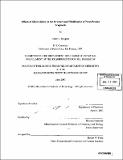Effects of glycosylation on the structure and fibrillization of prion protein fragments
Author(s)
Bosques, Carlos J. (Carlos Javier), 1974-
DownloadFull printable version (6.531Mb)
Other Contributors
Massachusetts Institute of Technology. Dept. of Chemistry.
Advisor
Barbara Imperiali.
Terms of use
Metadata
Show full item recordAbstract
It is now accepted that the structural transition from PrPc to PrPSc is the major event leading to transmissible spongiform encephalopathies. Although the mechanism of this transition remains elusive, glycosylation has been proposed to impede the PrPc to PrPSc conversion. Structural studies on glycoprotein fragments in the Imperiali group has previously shown that N-linked glycosylation can play a major role modulating polypeptide conformation. It has also been shown that glycosylation can alter the thermodynamics of disulfide bond formation, favoring oxidation. To address the role of glycosylation on PrP, we have prepared glycosylated and unglycosylated peptides derived from the 175-195 fragment of the human prion protein. The synthesis of a Fmoc-Asn[chitobiose(TBDMS)5-OH amino acid precursor allowed the preparation of the glycopeptide in high yields. Comparison of the structure, aggregation kinetics, fibril formation capabilities and redox susceptibility of Cys 179 has shown that the N-linked glycan (at Asn 181) significantly reduces the rate of fibrillization by promoting intermolecular disulfide formation via Cys 179. Furthermore, the aggressive fibrillization of a C179S mutant of this fragment highlights the significant role of disulfide stability in retarding the rate of fibril formation. Additionally, a novel method for the temporal control of fibrillization of this peptide was developed using a synthetic photolabile linker and a "fibril inhibitory unit" positioned at the N-terminus of the peptide. This stabilized the fragment as a soluble monomeric species until photoactivation, which triggered the peptide self-assembly.
Description
Thesis (Ph. D.)--Massachusetts Institute of Technology, Dept. of Chemistry, 2003. Vita. Includes bibliographical references.
Date issued
2003Department
Massachusetts Institute of Technology. Department of ChemistryPublisher
Massachusetts Institute of Technology
Keywords
Chemistry.